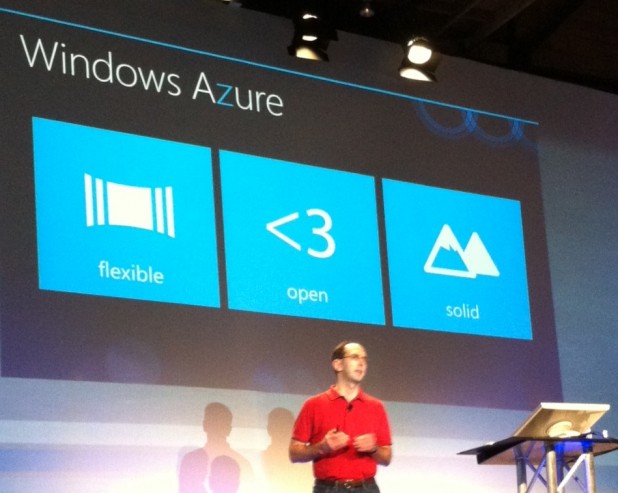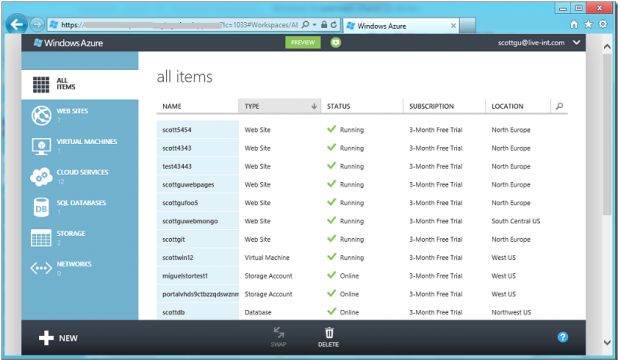[caption id="attachment_1549" align="aligncenter" width="618" caption="Microsoft executive Scott Guthrie walks the keynote audience through Windows Azure's new features."]

[/caption] Microsoft is updating its Windows Azure services for developers, with new capabilities including Infrastructure-as-a-Service (IaaS) and persistent virtual machines for running both Windows and Linux applications in the cloud. The combined capabilities are designed to facilitate the building of applications across both cloud and on-premises servers. During a June 7 event to unveil the new Azure, Microsoft executives kept emphasizing how well the Microsoft and open-source environments will play together in the sandbox. “We’re more flexible than ever,” Scott Guthrie, corporate vice president of Windows Azure, Application Platform, told the audience in the opening minutes of his keynote. “Our support of Linux is just one example of how we’re embracing openness in a fundamental way.” Windows Azure will feature new language libraries for Java, PHP, Node.js, and .NET, as well as command-line support for Mac and the ability to bring customized Linux images into the Azure cloud environment. The new services also include Windows Azure Virtual Machines, which allow developers and engineers to shuttle virtual hard disks (VHDs) between their cloud and on-premises setups. Users can either bring a customized Windows Server or Linux image into the environment, or else choose one from a gallery. Compatible operating systems and images available in the online gallery include, on the Microsoft side, Windows Server 2008 R2, Windows Server 2008 R2 with SQL Server 2012 Eval, and Windows Server 2012 RC. On the Linux side, supported platforms include OpenSUSE 12.1, CentOS-6.2, Ubuntu 12.04, and SUSE Linux Enterprise Server 11 SP2. During his presentation, Guthrie used his terminal to create a virtual machine, picked a size, chose a data center, and set up a virtual machine to configure how he wanted. The whole process took a short amount of time. “Anything I install on this virtual machine will persist,” he said. “Infrastructure-as-a-Service is not just the ability to upload VMs into the cloud and run them, but also integrate those features with existing solutions.” In addition, there’s the ability to provision and manage virtual private networks via the Windows Azure Virtual Network service, which lets users configure IP addresses and security policies (along with other features of network topology).
 Windows Azure Web Sites
Windows Azure Web Sites Developers can use Windows Azure Web Sites to build Websites and applications, with deployment via open-source applications such as Umbraco, DotNetNuke, and WordPress; the platform lets users deploy up to 10 Websites in a free, shared/multi-tenant hosting environment (developers can upgrade to an isolating “reserved mode” that lets them become the only customer on a virtual machine). Windows Azure Web Sites supports Visual Studio, Git, FTP, and Microsoft WebMatrix, along with Windows Azure SQL Database and MySQL databases.
Windows Azure SDK Windows Azure SDK June 2012 features the aforementioned support for Java, Python, PHP and .NET, as well as the command-line support for Mac and Windows, allowing for app development and deployment from the developer’s preferred type of workstation. Microsoft has made Azure SDKs, published under an Apache 2 license and kept in GitHub repositories, available in multiple languages.
Competition “Azure competes with Amazon and other hosted cloud offerings,” Rob Enderle, principal analyst of the Enderle Group, wrote in an email. “This is a very unique product for Microsoft because it puts them solidly in the full-service space, which is unusual for a company that is primarily a parts firm where a partner (channel or OEM) provides the solution.” In that context, he added, the decision to emphasize support for both Microsoft and open-source software makes perfect sense: “Azure is Microsoft’s strongest hedge against the collapse of the specialization model that created it.” It also allows Microsoft to offer customers a comprehensive cloud service at a time that other competitors—including Oracle—are also shouldering their combined way into the space.
Images: Jeffrey Drobick (top), Microsoft  [/caption] Microsoft is updating its Windows Azure services for developers, with new capabilities including Infrastructure-as-a-Service (IaaS) and persistent virtual machines for running both Windows and Linux applications in the cloud. The combined capabilities are designed to facilitate the building of applications across both cloud and on-premises servers. During a June 7 event to unveil the new Azure, Microsoft executives kept emphasizing how well the Microsoft and open-source environments will play together in the sandbox. “We’re more flexible than ever,” Scott Guthrie, corporate vice president of Windows Azure, Application Platform, told the audience in the opening minutes of his keynote. “Our support of Linux is just one example of how we’re embracing openness in a fundamental way.” Windows Azure will feature new language libraries for Java, PHP, Node.js, and .NET, as well as command-line support for Mac and the ability to bring customized Linux images into the Azure cloud environment. The new services also include Windows Azure Virtual Machines, which allow developers and engineers to shuttle virtual hard disks (VHDs) between their cloud and on-premises setups. Users can either bring a customized Windows Server or Linux image into the environment, or else choose one from a gallery. Compatible operating systems and images available in the online gallery include, on the Microsoft side, Windows Server 2008 R2, Windows Server 2008 R2 with SQL Server 2012 Eval, and Windows Server 2012 RC. On the Linux side, supported platforms include OpenSUSE 12.1, CentOS-6.2, Ubuntu 12.04, and SUSE Linux Enterprise Server 11 SP2. During his presentation, Guthrie used his terminal to create a virtual machine, picked a size, chose a data center, and set up a virtual machine to configure how he wanted. The whole process took a short amount of time. “Anything I install on this virtual machine will persist,” he said. “Infrastructure-as-a-Service is not just the ability to upload VMs into the cloud and run them, but also integrate those features with existing solutions.” In addition, there’s the ability to provision and manage virtual private networks via the Windows Azure Virtual Network service, which lets users configure IP addresses and security policies (along with other features of network topology).
[/caption] Microsoft is updating its Windows Azure services for developers, with new capabilities including Infrastructure-as-a-Service (IaaS) and persistent virtual machines for running both Windows and Linux applications in the cloud. The combined capabilities are designed to facilitate the building of applications across both cloud and on-premises servers. During a June 7 event to unveil the new Azure, Microsoft executives kept emphasizing how well the Microsoft and open-source environments will play together in the sandbox. “We’re more flexible than ever,” Scott Guthrie, corporate vice president of Windows Azure, Application Platform, told the audience in the opening minutes of his keynote. “Our support of Linux is just one example of how we’re embracing openness in a fundamental way.” Windows Azure will feature new language libraries for Java, PHP, Node.js, and .NET, as well as command-line support for Mac and the ability to bring customized Linux images into the Azure cloud environment. The new services also include Windows Azure Virtual Machines, which allow developers and engineers to shuttle virtual hard disks (VHDs) between their cloud and on-premises setups. Users can either bring a customized Windows Server or Linux image into the environment, or else choose one from a gallery. Compatible operating systems and images available in the online gallery include, on the Microsoft side, Windows Server 2008 R2, Windows Server 2008 R2 with SQL Server 2012 Eval, and Windows Server 2012 RC. On the Linux side, supported platforms include OpenSUSE 12.1, CentOS-6.2, Ubuntu 12.04, and SUSE Linux Enterprise Server 11 SP2. During his presentation, Guthrie used his terminal to create a virtual machine, picked a size, chose a data center, and set up a virtual machine to configure how he wanted. The whole process took a short amount of time. “Anything I install on this virtual machine will persist,” he said. “Infrastructure-as-a-Service is not just the ability to upload VMs into the cloud and run them, but also integrate those features with existing solutions.” In addition, there’s the ability to provision and manage virtual private networks via the Windows Azure Virtual Network service, which lets users configure IP addresses and security policies (along with other features of network topology).  Windows Azure Web Sites Developers can use Windows Azure Web Sites to build Websites and applications, with deployment via open-source applications such as Umbraco, DotNetNuke, and WordPress; the platform lets users deploy up to 10 Websites in a free, shared/multi-tenant hosting environment (developers can upgrade to an isolating “reserved mode” that lets them become the only customer on a virtual machine). Windows Azure Web Sites supports Visual Studio, Git, FTP, and Microsoft WebMatrix, along with Windows Azure SQL Database and MySQL databases. Windows Azure SDK Windows Azure SDK June 2012 features the aforementioned support for Java, Python, PHP and .NET, as well as the command-line support for Mac and Windows, allowing for app development and deployment from the developer’s preferred type of workstation. Microsoft has made Azure SDKs, published under an Apache 2 license and kept in GitHub repositories, available in multiple languages. Competition “Azure competes with Amazon and other hosted cloud offerings,” Rob Enderle, principal analyst of the Enderle Group, wrote in an email. “This is a very unique product for Microsoft because it puts them solidly in the full-service space, which is unusual for a company that is primarily a parts firm where a partner (channel or OEM) provides the solution.” In that context, he added, the decision to emphasize support for both Microsoft and open-source software makes perfect sense: “Azure is Microsoft’s strongest hedge against the collapse of the specialization model that created it.” It also allows Microsoft to offer customers a comprehensive cloud service at a time that other competitors—including Oracle—are also shouldering their combined way into the space. Images: Jeffrey Drobick (top), Microsoft
Windows Azure Web Sites Developers can use Windows Azure Web Sites to build Websites and applications, with deployment via open-source applications such as Umbraco, DotNetNuke, and WordPress; the platform lets users deploy up to 10 Websites in a free, shared/multi-tenant hosting environment (developers can upgrade to an isolating “reserved mode” that lets them become the only customer on a virtual machine). Windows Azure Web Sites supports Visual Studio, Git, FTP, and Microsoft WebMatrix, along with Windows Azure SQL Database and MySQL databases. Windows Azure SDK Windows Azure SDK June 2012 features the aforementioned support for Java, Python, PHP and .NET, as well as the command-line support for Mac and Windows, allowing for app development and deployment from the developer’s preferred type of workstation. Microsoft has made Azure SDKs, published under an Apache 2 license and kept in GitHub repositories, available in multiple languages. Competition “Azure competes with Amazon and other hosted cloud offerings,” Rob Enderle, principal analyst of the Enderle Group, wrote in an email. “This is a very unique product for Microsoft because it puts them solidly in the full-service space, which is unusual for a company that is primarily a parts firm where a partner (channel or OEM) provides the solution.” In that context, he added, the decision to emphasize support for both Microsoft and open-source software makes perfect sense: “Azure is Microsoft’s strongest hedge against the collapse of the specialization model that created it.” It also allows Microsoft to offer customers a comprehensive cloud service at a time that other competitors—including Oracle—are also shouldering their combined way into the space. Images: Jeffrey Drobick (top), Microsoft 